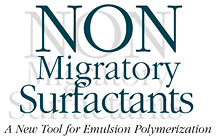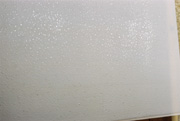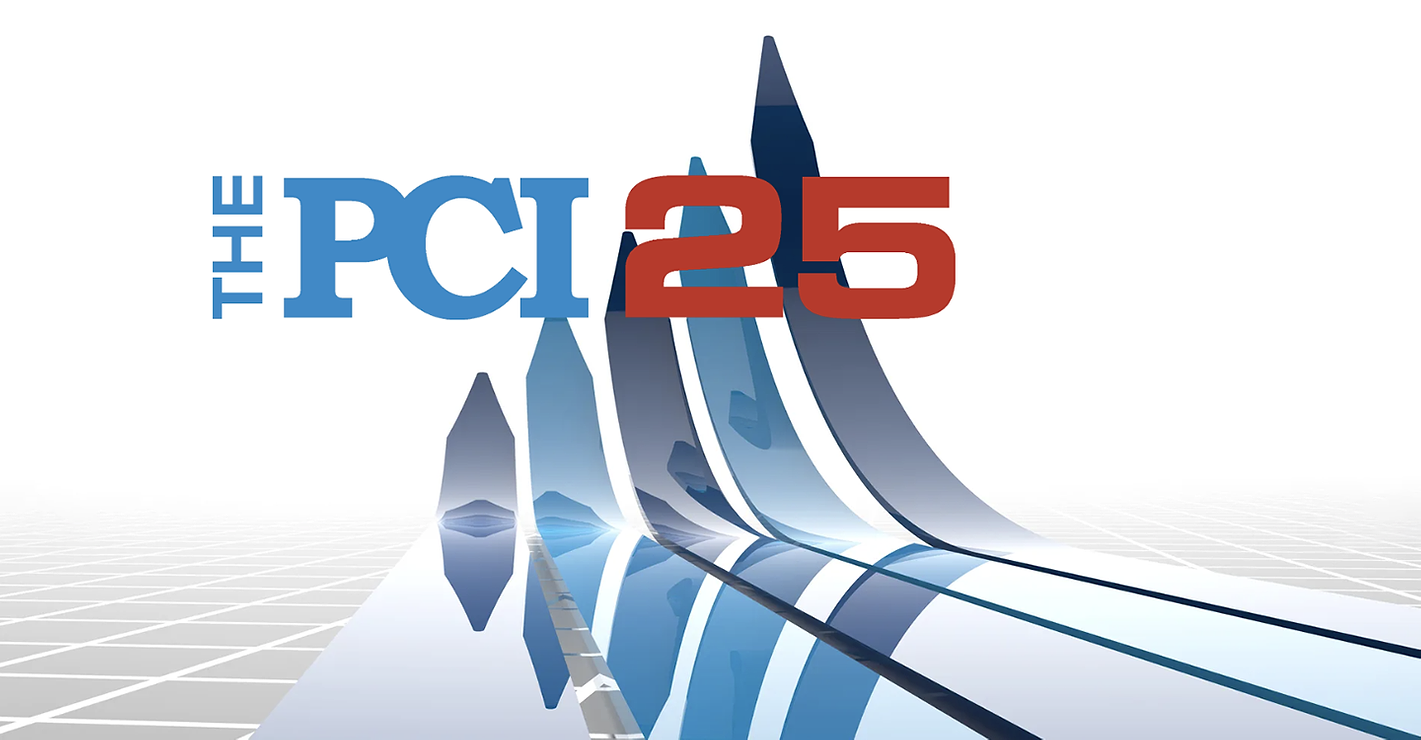Non Migratory Surfactants

Around two million tons of polymer are produced annually by way of emulsion polymerization or other heterogeneous polymerization processes. These waterborne polymer dispersions are used in many applications, including protective coatings, paper coatings, binders for textile printing or for non-woven fabrics, adhesives, additives for concrete, and with polymers used in the treatment of leather.
The end product of an emulsion polymerization is a dispersion of polymer particles in water, otherwise known as the latex. Surfactants are crucial in the production, storage and use of emulsion polymers. They control the particle nucleation stage, and thus affect latex particle size, stabilize monomer pre-emulsions, and prevent particle growth by way of agglomeration. Furthermore, surfactants are essential for controlling the colloidal stability of the dispersion during synthesis, storage, compounding, application and, ultimately, film formation.
The market for surfactants in these processes is of the order of several tens of thousands of tons worldwide. It is highly competitive, with an annual growth rate of around 2%. Through constant pressure in areas such as VOC reduction, polymer suppliers are continuously developing new technologies for use in protective coatings, paper coatings and adhesives, with a particular emphasis on waterborne resins and polymers.
Necessary Evil?
Surfactants are often described as a necessary evil: necessary for the reasons previously listed; evil as they increase the water sensitivity of the final coating and affect gloss and adhesive properties. In addition, the surfactant may fail to adequately stabilize the latex in difficult conditions, such as if applied at high speed or when mixed with other colloidal systems. The root cause of poor surfactant performance is the inherent weak hydrophobic interaction between surfactant and polymer phase.There are three main areas of concern: stability, protection and appearance.
Stability. External stresses cause the latex particles to flocculate. Conventional physically adsorbed surfactants may fail to protect the colloidal system in extreme conditions, such as freezing during storage, or from stresses produced during pumping, formulating or high-speed application. Also in complex formulations, such as pigmented or plasticized coatings or tackified adhesives, surfactant desorption and preferential redistribution will leave interfaces unprotected. This results in partial or complete coagulation.
Protection. The presence of conventional surfactants in the dry film results in increased water sensitivity of the coating. Barrier properties are undermined and adhesion is poor. The root cause for surfactant failure is the incompatibility between the surfactant and the polymer matrix. This results in phase separation during film formation and the appearance of hydrophilic surfactant domains.
High water uptakes are due to the presence of microvoids in the dry film. Two reasons exist for the presence of these tiny holes:
- Chaotic particle flocculation during water evaporation at low surfactant concentration similar to the poor colloidal stability when particles pack closely together, or
- The presence of excess surfactant in the latex and aggregation of these compounds into inverse micelles in the dry film
The water swells the film and diffusion rates of water through the coating increase sharply. Surfactant migration toward the interface between film and substrate causes adhesive failure and delamination of the coating.
Appearance. The presence of surfactants reduces the gloss of the dry film, enhances dirt pickup and whitens the film in humid conditions. Again, the immiscibility of hydrophobic polymer and hydrophilic surfactant is the driver for surfactant migration to the film surface resulting in poor gloss and tackiness of the surface. Leveling of the film surface is hindered and a rough, cratered surface is left after the surfactant is washed off. In addition, excess surfactant at the upper film layer causes plasticization of the surface and a tacky film results. Rapid whitening or blooming of the dry film in humid conditions, due to water absorbing in microvoids in the bulk of the film, is also observed.
Minimizing the negative effects of surfactant presence in waterborne polymer systems has prompted tremendous research effort in recent years.
There are existing industrial processes for emulsion polymerization that are so-called ‘surfactant free’; however, these processes generate surface active oligomers in-situ, and the final products have the same drawbacks as listed above.
The consequences of poor film properties in a kitchen or washroom coating formulation, for example, are self-evident; however, they have widespread applicability across many market segments.

Non-Migratory Surfactant (NMS)
It is generally accepted that one way to overcome the drawbacks of conventional surfactants is to covalently link them to the polymer particle surface. The surfactant remains in the film, but also remains evenly distributed, as phase separation is no longer possible. Figure 1 gives a schematic example of the difference between such non-migratory surfactants (NMS) and conventional surfactants. Moreover, polymer particles with an irreversibly adsorbed protective layer will have superior colloidal stability.Many NMS surfactants have been proposed and several commercialized in recent years; however, they have not achieved widespread acceptance. The selection and design of an effective NMS technology requires a good understanding of both surfactant and polymer science. For Uniqema, this underpinning knowledge has been supplemented by several years of close collaboration with leading academic groups in Europe. These cooperative research projects have given fundamental insights into molecular parameters such as electrosteric stabilization and reactivities between NMS candidate molecules and the main monomers.
This has resulted in the creation of a new generation of non-migratory surfactants. Experimental evidence is available for the enhanced performance of binders formulated with these new reactive surfactants. Two nonionic ‘surfmers’ are now commercially available: Maxemul™ 5010 and 5011. Advantages of using these NMS can be translated into real value in the various end-applications.

Colloidal Stability
Freeze/thaw stable latices are formulated using NMS. Products can be stored at temperatures down to – 20°C, without the need for using volatile freezing point depressants. Pressures created during the freeze-thaw cycles are unable to displace the grafted surfactant from the surface of the particles. No coagulation appears when the latex turns liquid again. Irreversibly adsorbed surfactants are able to keep the latex in a colloidally stable state, even when shear forces are applied. This allows for a faster application of the coating, using higher pressures or faster application speeds. Preferential adsorption is avoided when the latex is mixed into the final formulation and this, in turn, allows for an overall reduction of the surfactant concentration. The effects of using Maxemul 5011 on colloidal stability is illustrated in Figures 2-3. A colloid stabilized VAc/VeoVa10 latex using either a conventional nonionic surfactant (Synperonic™ NP20) or the Maxemul surfmer was subjected to high shear and five freeze-thaw cycles from ambient temperature to – 20°C. Particle size distributions before and after stress tests were measured using static laser light scattering. The appearance of a second generation of large particles with the conventional latex formulation shows the partial coagulation of latex particles. This latex is not freeze-thaw stable. The superior performance of the Maxemul 5011 formulation is evidenced by the fact that the average particle size distribution remains unchanged, after shearing for 15 minutes at 3,000 rpm and after five freeze-thaw cycles to – 20°C.

The experiment again demonstrates the superior colloidal stability of the Maxemul latex, even in the presence of 50 wt% of filler particles. This latex also shows superior pigment wetting and the test is an indication that this latex can be used as grinding resin.

Film Properties
Water repellent polymer films are obtained from latices formulated with NMS. The films absorb practically no water or whiten even when immersed for long periods. Dense packing of the polymer particles during film formation and absence of surfactant micelles in the film results in a dense coating that water cannot penetrate. In addition, surfactant cannot hinder the leveling of the coating and a high gloss is obtained. The effects of using Maxemul 5010 and 5011 on water resistance and appearance of the dry film is illustrated in Figure 4. Colloid free VAc/BA films, 100µm thick, were immersed in water for seven days and kept at ambient temperature. The films that contain conventional alcohol ethoxylate surfactant rapidly turned white, swelled and absorbed almost 50% of their own weight of water. In comparison, films made with Maxemul 5010 and 5011 absorbed only 10-15% of water, showed no blushing and did not swell.



We anticipate that the use of NMS will also boost the performance of waterborne adhesives. Superior water resistance allows use of wet lamination and gives absence of whitening for pressure sensitive adhesives on transparent labels. In addition, absence of leacheable surfactants guarantees a stronger adhesive bond strength over longer times and adverse weather conditions.
Conclusion
The advantages of using a new non-migratory surfactant in emulsion copolymer latices have been demonstrated. Straightforward replacement of conventional surfactants with these novel structures is possible. A step change in performance is observed, with the latex itself and also in the dry polymer film, giving major advantages to the final polymer product.Acknowledgements
Uniqema has worked closely with Professor Jose Asua and colleagues of the University of the Basque Country in San Sebastian during the development of these products.MAXEMUL, SYNPERONIC and UNIQEMA are trademarks of the ICI Group of Companies.
Looking for a reprint of this article?
From high-res PDFs to custom plaques, order your copy today!




